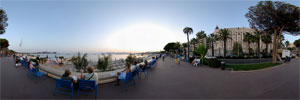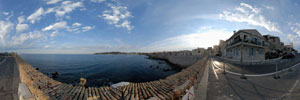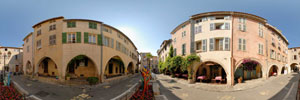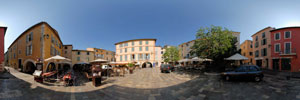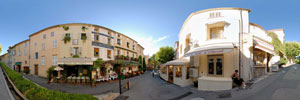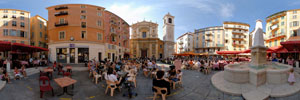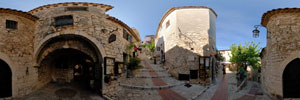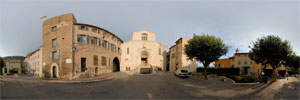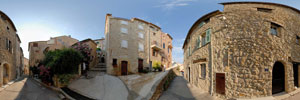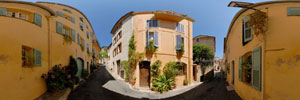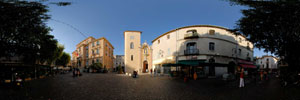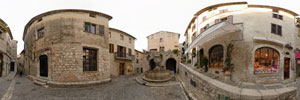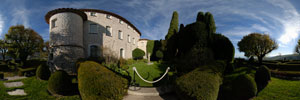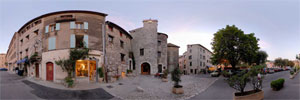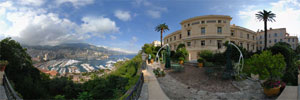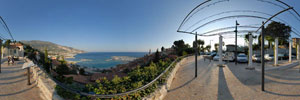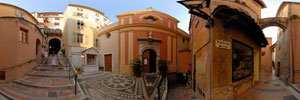Nice Panorama
- News :
- French Riviera :
- Provence :
- Var :
- Leisure :
- Gastronomy :
- Sport :
- Accommodation :
- Tourism :
- Site plan :
Virtual visit of the French Riviera with fullscreen panoramas

Around Cannes
Cannes
is an elegant city of international repute. It is located along the Mediterranean and is protected by Mistral Esterel. Cannes therefore benefits from an exceptional climate and summer vacationers will be able to enjoy its sandy beaches. This dynamic city has established itself internationally through its many festivals, including the most famous one dedicated to cinema. The visit of the city enables to discover its many facets.
Along the famous Croisette, a broad avenue lined with palm trees by the sea, tourists will not fail to admire the grand hotels and palaces with legendary names: Majestic, Carlton, Martinez, Noga. La Croisette and Rue d’Antibes (parallel road), offer a succession of luxury boutiques and jewelers. At the end of the Croisette, the residential area of California is home to beautiful mansions dating from the pomp of the 19th (Castle Louis XIII, Villa Fiesole, Villa Rothschild). We can also admire the yachts and sailing boats on the docks of Port Canto.
Cannes has remained until the 19th century, a small fishing village around Mont Chevalier (historic Suquet). It was only then that the English aristocracy (among others with Lord Brougham) has led to the current development of the city. The historic district of Le Suquet retains the charm of Provencal villages: the streets are narrow and buildings with colorful shutters are glued to each other.
The islands of Lerins (Sainte-Marguerite and Saint-Honore) are facing the city. The beautiful beaches and walks you bring disorientation. Sainte-Marguerite, the largest, has a park of 170 hectares and some of the most beautiful beaches of the Cote d’Azur. The island is famous for its Fort Vauban, who was a royal prison and housed, among others, the man in the Iron Mask. The fort also houses the Maritime Museum with its collection of underwater archeology. St. Honore is the property of the monks and houses a Cistercian monastery dating from the feudal era (13th and 15th cloister, walkway). Visitors should be respectful of the quiet of the monastic life and unspoiled natural environment.
Antibes
would have been based in the 5th or in 4th century BC by Phocaeans of Marseille. Antibes was then an episcopal see between the 4th and the 13th century. It is at this time that the episcopal see was transferred to Grasse.
The Grimaldi family, native of Genoa and ally of the Angevins, received the fief of Antibes of the Pope of Avignon in refund of a debt. They became established there towards the end of the 14th century. The Dédition of Nice in the 14th brought a border near Antibes. The efforts of fortifications became intensified during the rivalries between Francois Ier and Charles the Fifth and continued till the end of the administration of Henri IV. At the beginning of the 17th, Henri IV having bought the city to the Grimaldi of Antibes, those settled down in the castle of Cagnes-sur-Mer until the French Revolution.
The dismantling of the fortifications of Antibes began in 19th century to accompany an increasing urbanization. At the end of the 19th, the sea resort of Juan-les-Pins was created. Nowadays, we can visit number of monuments bound to this history. Let us quote, for example, the Fort Carré built in 16th century under Henri II and developed in the end of 17th century under Louis XIV by Vauban and the Castle of Grimaldi (15 and 16th centuries) which shelters nowadays the Picasso museum. The visit of the old town and the ramparts offers a beautiful sight on the cape of Antibes. We can flanner on the covered Provencal market or visit the Peynet museum.
The port Vauban, one of the biggest pleasure port of Europe, welcomes every spring during the "Sails of Antibes" an important Classic gathering of Yachts in the Mediterranean Sea. Every summer, the Festival of jazz of Juan-les-Pins takes place and fireworks are organized by the biggest artificiers. The World Festival of Underwater Pictures is held in autumn. The visit of the Marineland of Antibes allow, youngs as big, to admire unique entertainments with killer whales, dolphins and sea lions.
Biot
a une histoire qui n'a pas échappée aux principales guerres qui ont eu lieu dans la région. Du 11ème au 13ème siècle, Biot appartient à l'évêque d'Antibes et au Comte de Provence. Au début du 13ème siècle, le Comte de Provence fait donation de terres à l'Ordre du Temple. La seigneurie de Biot est alors partagée entre l'êvèque de Grasse et les Templiers. Au début du 14ème siècle, après l'abolition du Temple, Biot est remis aux Hospitaliers de Saint-Jean de Jérusalem ("Chevaliers de Malte").
A la fin du 14ème siècle, la peste noire et la guerre des bandes ont raison de la population qui abandonne le village. Il faudra attendre la fin du 15ème siècle pour que le roi René repeuple Biot avec une cinquantaine de familles venue de Ligurie. Au 16ème siècle, le village subit un siège par les troupes du Duc de Savoie. Au 18ème siècle, le village est pillé à deux reprise par des troupes austro-sardes puis austro-piémontaises.
Biot a toujours su attirer des artisants. Au 18ème siècle, Biot comptait ainsi 32 fabriques de poteries employant près de 200 ouvriers. De nos jours Biot, Biot a recu de la Société d'Encouragement aux Métiers d'Art et la Confédération Nationale des Métiers d'Art le label national "Ville et Métiers d'Art". Il est vrai que le savoir-faire des artisants (maîtres verriers, potiers, céramistes et bijoutiers joailliers) installés dans ce village est grand.
Biot comporte de nombreuses verreries ainsi que l'Ecomusée du Verre et la galerie internationale du verre. Biot accueille aussi de nombreux musées : le musée national Fernand Léger, le musée d'histoire et de céramiques biotoises, et le musée du Bonsaï.
La visite du village permet d'admirer la place de l'Eglise avec son pavement polychrome dessinant deux croix de Malte ainsi que l'église reconstruite au 15ème siècle. On pourra flanner sur la place des Arcades avec son architecture caractéristique et regarder les deux portes du village datant du 16ème.
Valbonne
is named after the founding of the Abbey of St. Mary, in the 12th century, on the grounds of an isolated and desert valley of the Sartoux territory that will become "Vallisbona" (the good valley). Valbonne was part of the 15 abbeys and priories of the monastic order of Chalais, an order found in the former provinces of Dauphiné and Provence (in south east of France). This order was created a century earlier by a rule close to that of the Cistercians. At the disintegration of this order in the late 13th century, Sainte Marie of Valbonne is competed by Avignon and Grasse. The pope himself must decide this case, old for almost 50 years, by giving Valbonne to the Abbey of Lerins.
In the late middle ages, plague, drought and barbarian invasions decimated and scare away the few people in surrounding villages, leaving the territories of the abbey ruined. To put back in value the lands of the abbey, Augustin of Grimaldi, Bishop of Grasse and abbot of Lerins takes the lead in the 16th century to create a village near the Abbey. The architecture used contrast with those of surrounding villages. It is based on the concept of Roman rectangular plan involving the central street, the street perpendicular and the central square. For defensive reasons, the "house walls" did not have doors on the outsid
The village will remain rural until the mid-20th century. The creations of the university, scientific, technological and residential district of Sophia-Antipolis, built largely on the forest of Valbonne, have transformed the region. Today almost 1,200 companies have settled, inccluding 900 on the commune of Valbonne Sophia Antipolis. This allowed the creation of 22,000 direct jobs in research organizations both public and private. The main areas of activity include health sciences, information, telecommunication and multimedia. Sophia Antipolis welcomes about 4000 students (3rd cycles of universities, colleges and preparatory classes).
Mougins
is situated between Cannes and Grasse on the Napoleon road. The old village was strengthened in the Middle Age. In the 11th century, the count of Antibes gave Mougins to the abbey of Lérins, which kept it until the Revolution. During the war of succession of Austria (18th century), the village was destroyed by a fire and plundered by the austro-Sardinian armies.
The main economic activity of the 19th century was the floral production (rose and jasmine) for the perfumers of Grasse. From half of the 20th century, Mougins became a great tourist and artistic place of the Côte d'Azur. Nowadays, Mougins welcomes on its territory near 20% of the technopole of Sophia-Antipolis.
Around Nice
Nice
, Prefecture of the Alpes-Maritimes, is the fifth largest city in France. Nice is the center of an urban area of more than 930 000 inhabitants. This vibrant city has many commodities as the second airport in France (nearly 10 millon passengers in 2006), two convention centers and business districts (Nice Arenas). Nice is the second French tourist town after Paris.
Nice is located on the shores of the Mediterranean at the bottom of the Bay of Angels. The city, is housed in a narrow mountain basin supported the Mercantour massif. It is bounded on the west by the Var valley and on the east by the Boron Mount. Several hills overlooking the city. The best known is named Cimiez with its ancient ruins, Chagall and Matisse museums, and old Belle Epoque hotels. Castle Hill separates the old city from the port. The town is crossed by two small torrential rivers: The Paillon on the east and The Magnan on the west.
Nice is famous for its old town, the Cours Saleya which hosts markets and restaurants, Chagall and Matisse museums, Mamac (contemporary art museum) and of course the promenade des Anglais, which stretches from the sylvan theater (outdoor theater) to the airport. The evening, Nice also offers some Jet-Set places (Negresco, many discos).
Eze
possesses as numerous villages situated near the seaside an animated history. In the 10th century, after the establishment of the village, Ezasques undergoes the occupation of the Moors. These last ones, established in Fraxinet behind Saint-Tropez, rob the populations of the Southeast during almost eighty years. They will be chased away from the region by Guillaume de Provence at the end of the 10th century.
The castle, built in the course of the 12th century, is seized by the count of Provence, Raymond Béranger V. It will be the property of the crown of Anjou-Provence from the 13th to the 14th century.
In the 14th century, Eze passes at Home of Savoy. Only maritime opening of the realm, the County of Nice presents a strategic interest. The counts of Savoy improve the fortifications of Eze and protect the town with a double strengthened door, the \"Poterne\". The castle undergoes numerous modifications to be adapted to the progress of the artillery.
In the 16th century, the Turkish fleet and it's French ally commanded by Barberousse seize the village. At the beginning of the 18th century, Louis XIV give a decisive blow to the town during the war of succession of Spain by ordering the destruction of the ramparts and castle to remove a possible point of resistance between Villefranche and Monaco.
Nowadays, the visit of the village shows the vestiges of this animated history. The visit of the exotic garden, at feet of the ruins of the castle, offers a very beautiful sight on the Cap Ferrat.
Around Grasse
Grasse
is a lovely city to visit. You can, while you stroll through the old town and its narrow streets, visit its many museums. So let us quote the International Perfume Museum, the Museum of Art and History of the Provence and the Villa Museum Jean-Honoré Fragonard.
Through an exceptional nature (jasmine, rose, lavender, orange blossom, tuberose), Grasse became the city of perfume. It thus appears as the essential place to be for any perfumer in the internationally-acclaimed bestseller “Perfume: The Story of a Murderer” by Patrick Suskind. You can also discover the manufacturing secrets by visiting ancient local factories (Fragonard, Molinard and Galimard).
Chateauneuf-de-Grasse
is a village listed in the inventory of historic sites in the Alpes-Maritimes. Built on a hill 417 m above sea level, the village is overlooking the plain of Opio and offers a beautiful view up the bay of Cannes and the Esterel Massif
The visit of the village allows observing, among other, some buildings of the XVI century, the church of St Martin build in the XVII century, and some vestiges of the old Castle (fortifications, ramparts and tower). The large building of the XVII century near the main square is called “the castle” because it is built on the ruins of the old Castle. It was a Seigneurial property. Finally, not far from Chateauneuf, one can discover the Notre Dame of Brusc chapel which is the remnant of a vast basilica, built in the XI century.
Le Bar-sur-Loup
is a medieval village located in the hinterland of Grasse. It deserves a visit not only for its panoramic views of Gourdon, the Gorges and the Valley of Loup but also for its very ancient houses, squeezed against each other around the Castle and the Church and its old streets where one can circulate only on foot.
The parochial church of St Jacques le Majeur is a monument of Roman and Gothic styles, which construction occurred between the XIIIth and the XVth century. It houses an altarpiece of late XVth century by the painter Louis Brea, which lived in Nice, and “Dance of Death”, painting on wood of the XVth.
A legend explains that the Count of Bar having given a ball in the middle of Lent, the guests fell dead. The “Dance of Death” was painted to commemorate the Divine punishment. It shows the Death, equipped as an archer, which kill the dancers with arrows. The souls out of the mouths of corpses, in the form of small naked figures, are weighed in the balance held by St. Michael, at the feet of Christ, and are precipitated into the jaws of a monster who represents the entrance to Hell.
The castle of Bar sur Loup also saw in 1722 the birth of Francois-Joseph Paul, Count of Grasse. This one became famous, at the behest of Louis XVI, as a lieutenant general of the naval forces. He went to the rescue of American fighting against the British for their independence and played an important role in the Battle of Yorktown bringing in 3000 men to support Washington, Lafayette and Rochambeau and resisting an English fleet to resupply the fort of Yorktown.
In the last century, Celestin Freinet was the pride of Bar sur Loup for its educational pedagogy that he began in the village from years 1920 to 1930 and then later in the village of St. Paul de Vence.
Vence
was founded by the Ligurian before becoming a Roman city (remains of columns provided by the city of Marseilles to the 3rd century).
Vence was then an important medieval city in the 12th century (the city is a rare nowadays to have preserved its ramparts). The city had at this time three doors, the Gate of Peyra, the Gate of Signadour and the Gate of Drawbridge. Of this period, you can visit the castle of Villeneuve (17th century) next to the guard tower (12th century), the former bishop and the сathedral (4th and 12th century).
In the 19th century, residents of Vence lived mainly due to the vine and olive agriculture. The city has developed with tourism in the 20th century and has attracted great painters like Matisse, Chagall, Dufy, Soutine and Arman. Matisse has decorated the Chapelle du Rosaire, a masterpiece of sacred art. The cathedral houses a mosaic by Marc Chagall “Moses rescued from the Nile”.
Nowadays, Vence offers to tourists a great visit of its streets full of history. Every summer, the world music festival “Nuits du Sud”, which was created in 1997, attracts 45,000 spectators in the city center.
Saint-Paul de Vence
has preserved behind it's ramparts raised on order of François Ier, the aspect of a feudal city guard of the ancient border of the Var.
Numerous artists and writers frequented the village and the Auberge de la "Colombe d'or", among whom Matisse, Modigliani, Chagall, Jean Giono, Jacques Prévert, Yves Montand and Simone Signoret.
Saint-Paul de Vence is a very frequented place for it's very numerous art galleries and for the Foundation Maeght, museum dedicated to the modern and contemporary art. The Foundation is situated in a garden decorated with numerous outdoors sculptures and welcome every year more than 200 000 guests. It exhibits works of Joan Miro and Alberto Giacometti. The summer, the permanent collection leaves the place to temporary exhibitions.
Gourdon
is one of the three villages classified as “The most beautiful villages of France” (by the association which aims to promote assets of small and picturesque French villages of quality heritage) located in the country subdivision of the Alpes-Maritimes. Located near the plateau of Gréolières and the Gorge of the Loup (river canyon), Gourdon is an ideal village to finish beautiful days spent outdoor in the fresh air (biking, hiking, paragliding).
The village has many artisans showcasing local products, including perfumes and honey from many flowers found on the plateau. The village has a special creative perfumery and toiletries, soaps and scented candles: “La Source Parfumée” and “Allongue Perfume”. The village has also manufacturers of confectionery and gingerbread (cake made with honey): “La Marquisette”, “La Maison du Miel Bon”. The village is also home to many artists: hand glass makers, silk creations and natural stones jewellery.
If you visit Gourdon, take time to discover the castle which houses two magnificent museums (The Museum of History and the Museum of Decorative Arts and Modernity) and the Gardens with different styles: terrace with French formal garden (also called “jardin à la française”) created by the landscape architect André Le Nôtre who also designed the Gardens of Versailles for Louis XIV, the terrace with Italian garden, the medieval garden and the Provencal garden.
Tourrettes-sur-Loup
is a village situated on a rocky spur easy to defend because situated on a plateau falling sheer. The village is strengthened by the outside houses which form a wall. Its alleys shelter the workshops of ceramists, painters, sculptors, leather workers and weavers.
Tourrettes-sur-Loup is the capital of the violet because it is the only village in France where this flower is cultivated as unique or main culture. In autumn and winters, flowers are picked to form bouquet of 25 surrounded with some leaves. In spring, when the bloom is plentiful, the flower is picked without the stalk for the confectionery. In summer, the leaf is mown to be transformed the same day in concrete then in absolute in the factories of Grasse. It enters in the composition of numerous perfume. The season is enclosed by the Holiday of Violets, which takes place according to the bloom, on 1st or 2nd Sunday of March.
Around Monaco
Monaco
is the second smallest independent state in the world after the Vatican. The principality paradoxically offers tourists many entertainments.
The visit of the old town on the Rock (rocky promontory extending into the Mediterranean,) allows to discover the Prince’s Palace, the Cathedral and the Oceanographic Museum with its famous aquarium. It is also the site of Monegasque institutions (Town Hall, Government, National Council (parliament of Monaco)).
The district of Monte Carlo is famous for its Casino, Hotel de Paris, the Opera and Ballet. That of Fontvieille houses the Stadium Louis-II where plays the AS Monaco football club. The stadium also hosts athletics meetings and the final of the European Super Cup.
The principality also serves as a framework for various sporting events which include the Monaco Formula 1 Grand Prix (world championship of Formula 1), the Rally Automobile Monte-Carlo and the Monte-Carlo Masters of the Monte Carlo Country Club.
Botanical Gardens lovers can visit the exotic garden of Monaco particularly in May when the cactuses are in bloom. Each winter, the city welcomes the International Circus Festival of Monaco.
Heritage Days are an excellent opportunity to discover the main attractions, including the grand apartments of the Prince’s Palace, the residence of Minister of State, the National Council. The Oceanographic Museum provides, at this occasion, a right of admission at reduced prices.
Menton
has a history associated with lemon since the 15th century. From a medieval culture (cereals, vines and fig trees), the inhabitants of Menton intensified the cultivation of olive trees (the first oil mills appear in the 14th century). The first citrus trees appear in the 15th taking advantage of the microclimate of Menton.
Menton is for five centuries (14th to 19th) under the suzerainty of the Princes of Monaco. In 1848, Menton seceded from the principality of Monaco with its neighbor Roquebrune because the Prince Florestan I of Monaco maintained a tax on the export of lemons, the main resource of these cities. Incorporated in free cities, they are administered by the house of Savoy until 1861 when they became French. Napoleon III paid a compensation of four million francs for the two cities to Prince Charles III of Monaco.
Today, the lemon is one of the symbols of the city of Menton. The Lemon Festival is hold in the city since over seventy years. It takes place between the last three weekends in February.
In July, the festival "Menton, my town is tango" is an opportunity to dance argentinian tango on the seafront with the regulars of the region but also many italian tourists. The festival organizes, for this occasion, some concerts, performances and dance workshops.
Menton contain many interesting monuments to visit. The Carnolès Palace, which is the former home of Antonio I of Monaco, and hosts the largest collection of citrus in France. The Bastion, which was built on the open sea in the 17th as a forward defence of the port, is today in the port of Menton and houses the Jean Cocteau Museum. The Town Hall with the wall paintings of the marriage hall by Jean Cocteau. The Basilica of Saint-Michel in Baroque style.
Thanks to its microclimate, Menton hosts exceptional gardens (Biovès Gardens, Botanical Garden Val Rahmeh, Fontana Rosa, Pian Park, La Serre de la Madone, Villa Maria Serena).
Roquebrune Cap-Martin
is a seaside resort located between Monaco and Menton. The municipality is constituted of very different neighborhoods.
The old village is located in a mountainous circus that dominates the mount Agel. It is crowned by the old castle and has kept intact its medieval character: narrow streets covered with Romanic arches.
This castle is the only specimen, in existence in France, of the castles called Carolingian, embryos of those built two centuries later and that marked the heyday of feudalism. It was founded in the 10th century, by Conrad I Count of Ventimiglia, to prevent the Saracens to settle in the region. For five centuries it belonged to the Grimaldi who modified the constructions and introduced the artillery in the defense.
The old village is also home to: St. Margaret’s church which was built in the twelfth century and restored several times, notably in the nineteenth century and a millennium olive considered the oldest in Europe.
Cap Martin is a long peninsula composed of beautiful villas surrounded by parklands. It is the symbol of the great architects and the tourism of holiday resort of the last century (villa of Tersling).
Cabbe, Bon Voyage and Serret are residential areas of Roquebrune-Cap-Martin. We find in these districts, various elements the architectural and cultural heritage of the municipality (Cabanon Le Corbusier, E-1027, Chapel Bon Voyage).
The sumptuous mansions present at Roquebrune-Cap-Martin show that writers, artists, architects came to look for the inspiration and for the rest on this place of exception: Sir Winston Churchill, Coco Chanel, Sacha Guitry, Jacques Brel, Silvana Mangano...
Provence
French Riviera
Départements
- Alpes de Haute Provence (04)
- Hautes Alpes (05)
- Alpes Maritimes (06)
- Bouches du Rhône (13)
- Var (83)
- Vaucluse (84)
Loisirs
- Photographie
- Argentinan Tango
- Voile
- Golf
- Culture & Traditions
- Parcs d’attractions, animaliers et aquatiques
- Theater
- Jazz
- Classical Music and Lyric Art
- Jazz, World music, Electonic Music
Informations pratiques
